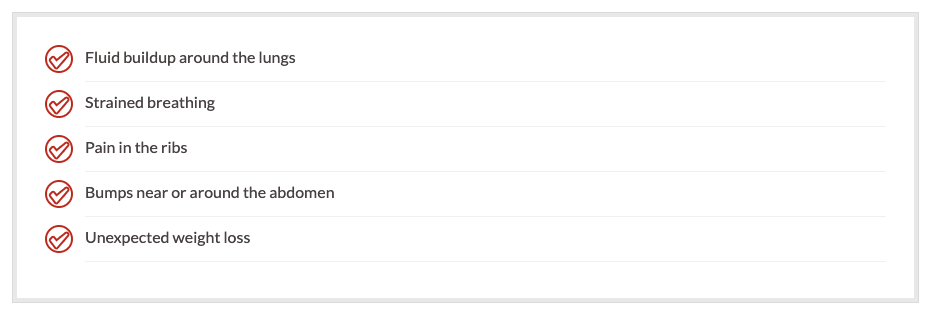
Malignant Mesothelioma
Malignant mesothelioma is a type of cancer commonly caused by inhaling asbestos fibers. The word “malignant” refers to cells that are cancerous while “mesothelioma” refers to cells of the mesothelium, which is the tissue lining that covers vital organs like the lungs, heart, and abdominal cavity. The most common form of mesothelioma is pleural mesothelioma, affecting the lungs, but mesothelioma can also affect the heart (pericardial mesothelioma) or the abdominal cavity (peritoneal mesothelioma).
People who are exposed to the carcinogenic fibers “asbestos” are at a greater risk of developing mesothelioma cancer at some point in their lives.
Many people who have been diagnosed with mesothelioma were exposed to asbestos at the workplace, particularly those who worked in industrial environments or veterans of the U.S. Navy. The latency period for mesothelioma is much longer than other cancers, meaning it can take up to 40 or more years after initial exposure to asbestos to develop the cancer.
Symptoms of Pleural Mesothelioma
Mesothelioma of the lungs can cause a variety of side effects, some of which mimic the side effects of other diseases, including:

If you are experiencing any of these symptoms and believe you were exposed to asbestos at some point in your life, you should contact a doctor to undergo diagnostic testing.
Malignant Mesothelioma vs. Lung Cancer
Mesothelioma is different from lung cancer. The best way for doctors to determine which a patient has is by diagnostic tests, often multiple. Your doctor will likely use the following to confirm or rule out a mesothelioma diagnosis:
- Physical Examination
The first step in the diagnostic process is a routine physical examination, which usually includes taking your vitals and checking for lumps or any other abnormalities. - Evaluating Your History
Your doctor will likely ask you about your health history, such as history of lung cancer in your family, possible exposure to asbestos in your past, and your health habits. - X-Ray
An x-ray examination of your chest cavity can yield important information about the state of your lungs. - Complete Blood Count
In a CBC procedure, you will provide a blood sample to be checked for a number of signals, including: number of red/white blood cells as well as platelets, how much hemoglobin is in your red blood cells, and how much of your total blood sample is red blood cells. - Sedimentation Rate
This type of test evaluates how quickly red blood cells from your blood sample settle at the bottom of a test tube. - Biopsy
There are various different methods for biopsies, but they all perform the same function – taking a tissue sample to be evaluated for cancer cells or markers. - Bronchoscopy
This process involves inserting a tube through a person’s trachea into the lungs to discover whether there are any abnormalities. - Cytology
Cytological exams are not always as accurate as traditional biopsies, but this option involves taking fluid samples from the area around the lungs to see if there are any abnormalities.
Determining a Prognosis
A patient’s chance of recovery, or “prognosis,” depends on a number of factors, including:
- What stage the cancer has reached
- How large the tumor is
- Whether the tumor can be removed through surgery
- How much fluid buildup there is in the chest/abdomen
- The age and general health of the patient
- The type of mesothelioma
- Whether this diagnosis is a recurrence of cancer or a first-time diagnosis
Mesothelioma Definitions
- Asbestos – Is a naturally occurring chemical fiber comprised of silicate minerals. The substance is a known carcinogen, meaning it causes cancer, specifically, mesothelioma. Although its risks were known much earlier, the substance was used in manufacturing through the 1980s.
- Biopsy – This is a procedure that involves removing tissue/cells for analysis. A pathologist analyzes the tissue sample under a microscope to see if it contains any cancerous cells.
- Bronchoscope – A bronchoscope is a fiber-optic cable that a doctor can use to see a patient’s lungs, airways, vocal chords, trachea, and other organs in that general area. The scope is inserted through the patient’s windpipe in the procedure known as a bronchoscopy.
- Complete Blood Count – A CBC is a type of test doctors use to analyze cells in a person’s blood. Doctors take blood samples and evaluate how many white blood cells, red blood cells, and platelets there are.
- Cytology – The cytology exam is similar to a biopsy in that it evaluates tissues and cells to determine if they are cancerous.
- Fine-Needle Aspiration – This type of procedure involves inserting a thin needle through an affected area (where there is a lump or mass) and drawing out cells for analysis.
- Hemoglobin – Hemoglobin is a red protein that your body needs to get oxygen in your blood.
- Laparotomy – This is a type of incision performed by a surgeon on a patient’s abdomen. Laparotomy can be used to both diagnose and prepare a patient for surgery.
- Malignant – The word “malignant” means cancerous, so paired with mesothelioma, this means cancerous cells in the mesothelium.
- Pathologist – This type of physician exclusively focuses on the study of bodily fluids and tissues. You might be referred to a pathologist by your primary care doctor if he or she suspects you have cancer.
- Peritoneum – The peritoneum is the thin tissue layer surrounding your abdominal cavity. That is why cancer of the peritoneum is referred to as peritoneal mesothelioma.
- Platelet – Platelets are cells found in a person’s blood. They are important because they bind together (clot) when they sense damage to the vessels.
- Pleura – The pleura is the thin tissue layer surrounding the lungs.
- Sedimentation Rate – This is a type of blood test that your physician might recommend if he or she suspects cancer. The test measures how quickly the red blood cells settle at the bottom of the test tube.
- Thoracoscopy – This thin, flexible tube is used to inspect a person’s lungs. It is inserted through a small cut in a person’s chest and has a camera on it for the surgeon to view the lungs and pleura.
- Thoracotomy – A thoracotomy is an incision into the wall of a patient’s chest.
- X-Ray – Imaging technology that uses radiation, in low doses, to provide images of a person’s insides.

Our Mission
-
Medical Empowerment
Get the information you need to make informed decisions about your treatment.
-
Legal Empowerment
Get the compensation you need to address the financial cost of your illness.
-
Going For The Gold
Helping empower our clients with over $2.5 Billion in recoveries. We fight for our clients!
-
Giving Back To The Community
Unprecedented Support for Mesothelioma Research. See how we can help!



